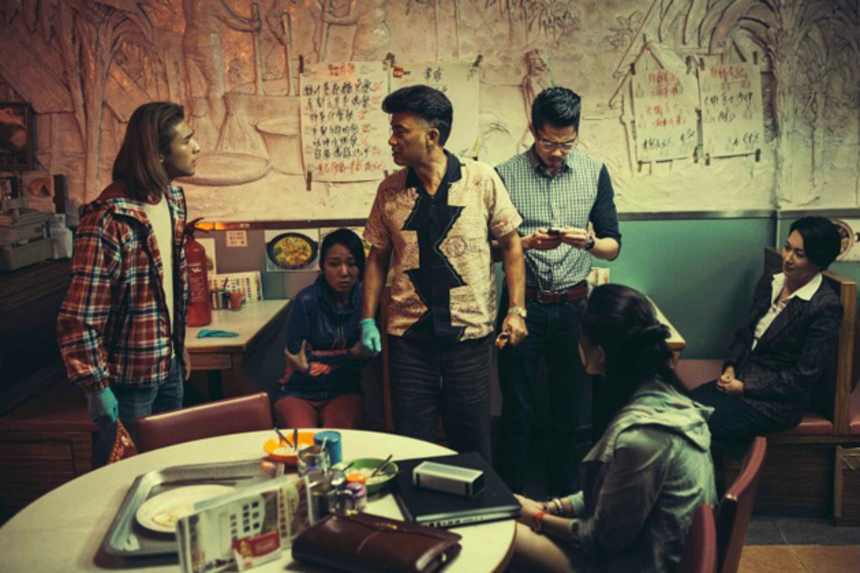Berlinale 2014 Review: THE MIDNIGHT AFTER, Fruit Chan's Maddening Pop-Art Apocalypse

The film starts dazzlingly enough. It's 2AM, and the city of Hong Kong is positively bursting with energy. Neon lights flash, cars whizz by and huge masses of people crowd the downtown. It is Saturday night, and it seems all of Hong Kong has come out to play. Chan captures that barely controlled chaos of big city life remarkably well. His camera roves back and forth like a rubbernecking tourist and his edits are sharp, fast and frequent as we are introduced to seventeen different characters. All of them are getting on to the same late night bus from the Hong Kong core to the district of Tai Po.
Each character is painted in broad strokes. There's a junky, a yuppie couple, a blond-haired Romeo, and a women in disguise. Then there's the bus driver, a slobby gambler played by Johnnie To regular Lam Suet. All of their fortunes will soon be entwined when the bus comes out of an underground tunnel to an empty city. It seems everyone else in Hong Kong has all of a sudden vanished, vaporized, disappeared without a trace. Or is them who have disappeared?
The film shares a close similarity to the television series Lost, an echo I don't believe unintentional, as the source novel (by PIZZA!) went under the title Lost on a Red Minibus to Taipo. As in the popular TV show, our seventeen characters have mysterious, sometimes eyebrow raising backgrounds -- the woman in disguise a fugitive from the law, the insurance broker a psychic with sorceress powers - and we flashback often to their lives before 'the event'. But where Lost exiled its cast of misfits to a secluded island, here the action is set in the erstwhile dense and highly populated streets of Hong Kong.
Chan uses that unusual sight to full effect, staging much of the manic action of the film's first half in lamp-lit hollowed out streets. Imagine the opening of the Vanilla Sky, where Tom Cruise wanders an empty Times Square, jacked up on Red Bull and meth. The visuals are equally vivid. There are plenty of canted angles and camera swoops, and the colors, from one character's red leather jacket to another's peroxide blonde hair, all pop as if pages from a freshly printed comic book.
That comedic first half, filled with foot chases, dorm room theorizing (What if we're all dead? What if we're moving to a new plane of astrological existence?), melodramatic breakdowns and spectacular deaths, hinges on the central question, "What the hell happened to everyone else?" It builds to the film's undisputed peak, a set piece, karaoke rendition of David Bowie's "Space Oddity" that is kind of amazing. The song, it seems, offers clues and hints at the nature of the situation. Might parsing its meaning bring this mystery into clearer light?
Spoiler alert: it doesn't.
As in Lost, The Midnight After is more interesting throwing out provocative, often outlandish theories that aren't quite red herrings, but never quite follow through. The film presents, among other things, North Korean spies, insinuations of time travel, a magical black box that contains all the secrets of Cantonese culture, aftereffects of the Fukushima meltdown and so, so much more, without ever doing much with them. The goal is not to actively seek answers to the first half's mystery, but to let the madcap insanity pummel you into submission.
The film's second half is set almost entirely in a rundown restaurant, where the characters have regrouped. The restaurant plays host to the absolute least welcome detour, a nearly twenty minute sequence of sexual assault, necrophilia and frontier justice, when the remaining survivors must decide what to do with a wolf in their midst. It is such an ugly detour, and so glib a treatment of a real and pervasive subject, that it stops the breezy, cartoonlike film in its tracks.
That, and the sudden whiplash of moving from so freewheeling and electric a first act to so inert a second. Giving up the ghost of ever figuring out what has happened, and left with flimsy characters in vile situations, the film totally deflates. It drags on an on, and one as a viewer cannot help but checkout. Which is too bad, because by the time the car chases begin anew and the blood rain falls from the sky, it is really hard to check back in.
The Midnight After
Director(s)
- Fruit Chan
Writer(s)
- Fai-Hung Chan (screenplay)
- Fruit Chan (screenplay)
- Ho-Yan Kong (screenplay)
Cast
- You-Nam Wong
- Janice Man
- Simon Yam
- Kara Hui

Do you feel this content is inappropriate or infringes upon your rights? Click here to report it, or see our DMCA policy.






